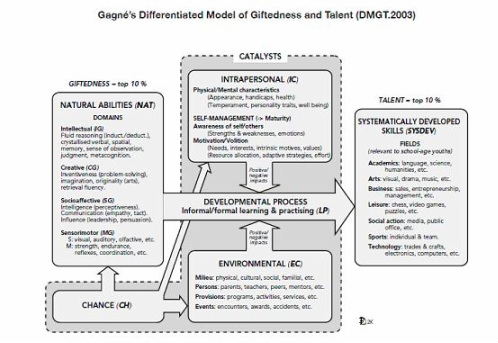Including giftedness
“How do we justify an educational system that ignores competence (what pupils are able to do) and achievement (what they have already mastered) and utilises chronological age as the primary, or only, factor in pupil placement?” (Ashman & Elkins, 2009, p. 73). Inclusion should not only be judged on chronological age, inclusion is about belonging – “gifted students, belonging will be reflected in participation and engagement in new and challenging learning … flexibility and choice … be eclectic and will include intellectual peers and peers with similar interests” (Ashman & Elkins, 2009, p. 73).
Teachers need to ensure that all relationship options are open with students, parents, other teachers and professionals surrounding giftedness because giftedness can be instilled in anyone of our students, you never know when giftedness is going to appear, it has “no respect for social or cultural background or for sex” (Ashman & Elkins, 2009, p. 76).
So, the best teachers can do is examine how to identify with and relate to giftedness.
Are you gifted?
Gagne defines giftedness as “the possession of natural abilities or aptitudes at levels significantly beyond what might be expected for one’s age, in any domain of human ability” (Gross, 2004, p. 4). The asynchronous development of a gifted student identifies the “marked difference between chronological age, intellectual development and affective development of the gifted person” (Ashman & Elkins, 2009, p. 71). Giftedness is an aptitude resting dormant ready to ignite.
However, there is a fine line between gifted students exhibiting giftedness or masking it. The forced-choice dilemma refers to gifted students making the decision to conform to the curriculum and be accepted by peers or excel in their area of giftedness and develop their intellectual capability. It is a complex and challenging time for gifted students who are fighting to find their identity and we as teachers must nurture and provide a safe learning environment for students’ gifts to flourish.
Are you talented?
In contrast, Gagne defines “talent as achievement or performance at a level significantly beyond what might be expected at a given age” (Gagne as cited in Gross, 2004, p. 5), which means “in simple terms, gifts are natural abilities whereas talents are systematically developed skills” (Baker, n.d, para 4-5).
Gifts and Talents work together to advance the asynchronous development of the gifted student and idealise the concept that high ability and potential meet high achievement and performance.
Teachers need to ensure that all relationship options are open with students, parents, other teachers and professionals surrounding giftedness because giftedness can be instilled in anyone of our students, you never know when giftedness is going to appear, it has “no respect for social or cultural background or for sex” (Ashman & Elkins, 2009, p. 76).
So, the best teachers can do is examine how to identify with and relate to giftedness.
Are you gifted?
Gagne defines giftedness as “the possession of natural abilities or aptitudes at levels significantly beyond what might be expected for one’s age, in any domain of human ability” (Gross, 2004, p. 4). The asynchronous development of a gifted student identifies the “marked difference between chronological age, intellectual development and affective development of the gifted person” (Ashman & Elkins, 2009, p. 71). Giftedness is an aptitude resting dormant ready to ignite.
However, there is a fine line between gifted students exhibiting giftedness or masking it. The forced-choice dilemma refers to gifted students making the decision to conform to the curriculum and be accepted by peers or excel in their area of giftedness and develop their intellectual capability. It is a complex and challenging time for gifted students who are fighting to find their identity and we as teachers must nurture and provide a safe learning environment for students’ gifts to flourish.
Are you talented?
In contrast, Gagne defines “talent as achievement or performance at a level significantly beyond what might be expected at a given age” (Gagne as cited in Gross, 2004, p. 5), which means “in simple terms, gifts are natural abilities whereas talents are systematically developed skills” (Baker, n.d, para 4-5).
Gifts and Talents work together to advance the asynchronous development of the gifted student and idealise the concept that high ability and potential meet high achievement and performance.
Gagne’s Differentiated Model of Giftedness and Talent demonstrates the transformation and relationship between natural abilities and systematically developed skills with catalysts such as intrapersonal and environmental, either assisting or hindering the learning developmental process of a gifted child.
Ashman and Elkins define the model as a “dynamic relationship between high potential and high performance. Gifts are developed into talents through the interaction between intrapersonal and environmental catalysts” (Ashman and Elkins, 2009, p. 67).
Teachers are a significant factor in the environmental element of the model and have the chance to control certain environmental aspects. We can develop engaging and challenging work for gifted students and promote a “class climate that encourages academic talent” (Gross, 2004, p. 7), so gifted students want to reveal their gifts rather than camouflage them.
Ashman and Elkins define the model as a “dynamic relationship between high potential and high performance. Gifts are developed into talents through the interaction between intrapersonal and environmental catalysts” (Ashman and Elkins, 2009, p. 67).
Teachers are a significant factor in the environmental element of the model and have the chance to control certain environmental aspects. We can develop engaging and challenging work for gifted students and promote a “class climate that encourages academic talent” (Gross, 2004, p. 7), so gifted students want to reveal their gifts rather than camouflage them.

